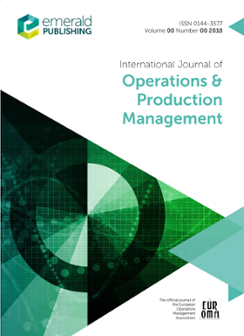紧急情况下的新兴技术
IF 7.4
2区 管理学
Q1 MANAGEMENT
International Journal of Operations & Production Management
Pub Date : 2021-10-12
DOI:10.1108/ijopm-09-2021-904
引用次数: 11
摘要
1. 新兴技术在紧急情况下的作用全球业务和供应链正在经历前所未有的剧变(Azadegan和Dooley, 2021;Scholten et al., 2020)。越来越多的自然灾害和COVID-19大流行使组织陷入紧急状态,许多组织为生存而战(Ivanov, 2020;Queiroz et al., 2020;Schleper et al., 2021)。紧急情况无论大小、短期或持续一段时间,都对个人的健康和生计、组织和社会福利以及更广泛的环境构成潜在风险(van deWalle和turoff, 2008年;Sarkis博士,2021)。紧急情况通常需要采取紧急行动,将业务恢复到以前的情景,或制定新的生存和适应全新情况的战略(伊万诺夫和多尔吉,2020年b;O 'Flynn, 2020)。由于这些事件的规模和即时性,通常涉及一系列行动者,包括政府、非政府组织和企业,他们需要共同努力减轻对生命和财产的威胁。为了找到摆脱当今紧急情况的方法,管理人员迫切需要关于如何快速重新部署业务资源和建立弹性的指导(Ivanov和Dolgui, 2021;Remko, 2020)。与工业4.0相关的新兴技术有助于组织重建和重新配置其弹性能力(Koh等人,2019;Spieske和Birkel, 2021)。最近关于新兴技术的学术工作加深了我们对供应链背景下工业4.0的理解,包括区块链(Wamba和Queiroz, 2020)、人工智能(AI) (Dwivedi等人,2019)、大数据分析(Fosso Wamba和Akter, 2019;Kache和Seuring, 2017),物联网(IoT) (Schroeder等人,2020)和3d打印(Kapletia等人,2019;罗斯科等人,2019)。然而,学术界关注有限的一个领域是在紧急情况下部署新兴技术。技术一直是并将继续作为增强性能的推动者。尽管缺乏研究,但很明显,新兴技术在应对紧急情况时可以作为协调机制和灵活的制造工具(Queiroz和Fosso Wamba, 2021),支持接近需求点的本地化制造(Srai等人,2020)。数字技术的最新进展可以加强紧急情况下的规划、动员和管理。例如,人工智能和商业分析可以快速识别处于困境中的人群(Fosso Wamba等人,2021)。社交媒体结合大数据分析可以在灾害期间协调当地志愿者的救援工作(Dubey et al., 2019;客人编辑本文章由计算机程序翻译,如有差异,请以英文原文为准。
Guest editorialEmerging technologies in emergency situations
1. The role of emerging technologies in emergency situations The world is witnessing an unprecedented upheaval in global operations and supply chains (Azadegan and Dooley, 2021; Scholten et al., 2020). Increasingly occurring natural disasters and the COVID-19 pandemic have plunged organisations into a state of emergency, with many fighting for their very survival (Ivanov, 2020; Queiroz et al., 2020; Schleper et al., 2021). Be they large or small, short-lived or sustaining for some time, emergency situations present a potential risk to an individual’s health and livelihood, organisational and societal welfare and to thewider environment (van deWalle andTuroff, 2008; Sarkis, 2021). Emergency situations typically require urgent action to restore operations to the previous scenario or new strategies for survivability and adaptation to an entirely new context (Ivanov and Dolgui, 2020b; O’Flynn, 2020). Due to the scale and immediacy of these events, a range of actors is often involved, including governments, non-governmental organisations and businesses that need to work together to mitigate threats to life and property. To find a way out of today’s emergency situations, managers urgently require guidance on how to rapidly redeploy operational resources and build resilience (Ivanov and Dolgui, 2021; Remko, 2020). Emerging technologies such as those related to Industry 4.0 are well-positioned to help organisations rebuild and reconfigure their resilience capabilities (Koh et al., 2019; Spieske and Birkel, 2021). Recent scholarly work on emerging technologies has deepened our understanding of Industry 4.0 in a supply-chain context, including research on blockchain (Wamba and Queiroz, 2020), artificial intelligence (AI) (Dwivedi et al., 2019), big data analytics (Fosso Wamba and Akter, 2019; Kache and Seuring, 2017), the Internet of Things (IoT) (Schroeder et al., 2020) and 3Dprinting (Kapletia et al., 2019; Roscoe et al., 2019). However, one area that has received limited scholarly attention is deploying emerging technologies in emergency situations. Technology has always been and continues to act as an enabler of enhanced performance. Despite the scarcity of research, it is clear that emerging technologies can act as a coordination mechanism and flexible manufacturing tool when responding to emergencies (Queiroz and Fosso Wamba, 2021), supporting localised manufacturing close to the point of need (Srai et al., 2020). Recent advancements in digital technologies can enhance planning, mobilisation and management during emergency situations. For example, AI and business analytics can quickly identify populations in distress (Fosso Wamba et al., 2021). Social media combined with big data analytics can coordinate the relief efforts of local volunteers during disasters (Dubey et al., 2019; Guest editorial
求助全文
通过发布文献求助,成功后即可免费获取论文全文。
去求助
来源期刊
CiteScore
13.30
自引率
17.20%
发文量
96
期刊介绍:
The mission of the International Journal of Operations & Production Management (IJOPM) is to publish cutting-edge, innovative research with the potential to significantly advance the field of Operations and Supply Chain Management, both in theory and practice. Drawing on experiences from manufacturing and service sectors, in both private and public contexts, the journal has earned widespread respect in this complex and increasingly vital area of business management.
Methodologically, IJOPM encompasses a broad spectrum of empirically-based inquiry using suitable research frameworks, as long as they offer generic insights of substantial value to operations and supply chain management. While the journal does not categorically exclude specific empirical methodologies, it does not accept purely mathematical modeling pieces. Regardless of the chosen mode of inquiry or methods employed, the key criteria are appropriateness of methodology, clarity in the study's execution, and rigor in the application of methods. It's important to note that any contribution should explicitly contribute to theory. The journal actively encourages the use of mixed methods where appropriate and valuable for generating research insights.

 求助内容:
求助内容: 应助结果提醒方式:
应助结果提醒方式:


